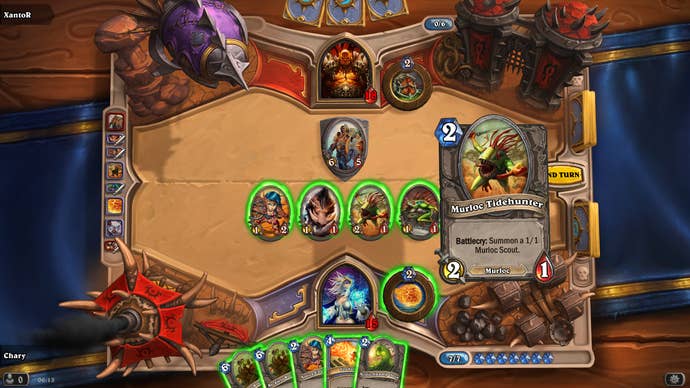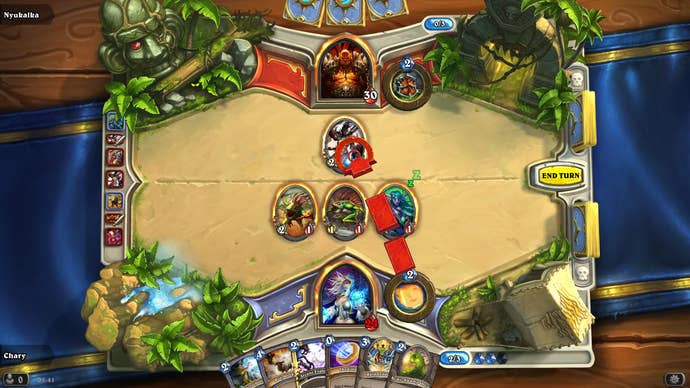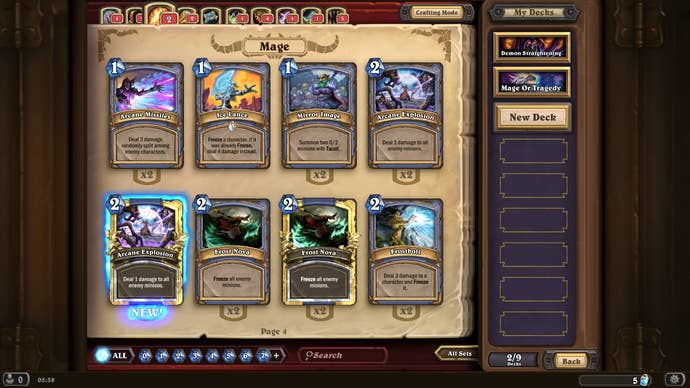Hearthstone: Blizzard's Secret Weapon
Eurogamer's Richard Cobbett asks what's in the cards for Warcraft's new cousin, and the future it predicts?
This article first appeared on USgamer, a partner publication of VG247. Some content, such as this article, has been migrated to VG247 for posterity after USgamer's closure - but it has not been edited or further vetted by the VG247 team.
Obvious as it is in more than one way, Blizzard played its cards perfectly with Hearthstone.
Its World of Warcraft-themed card game -- which goes into open beta next month, incidentally -- began as a side project. Almost immediately, it became a phenomenon. Over a million keys have been sent out during the closed beta, and still that's nowhere near enough. Sites have buckled under the stress. Howls of protest have echoed throughout the net. Quite possibly the developers of Scrolls have wept, and not without cause if so.
Much like Heroes of the Storm, Hearthstone is a game designed more with newcomers to its genre in mind than old hands. Magic: The Gathering players, for instance, might complain about it only having one resource (mana), the absence of terrain as a factor, the relatively basic cards, and the reliance of the mid-game especially on card draw. All of those are valid, and Hearthstone is definitely simpler. However, this not being a Yu-Gi-Oh style world where everyone is already neck-deep in card games, there's a massive audience scared off by those concepts for whom something that can be picked up in an hour is a huge advantage -- especially when the lore and major characters are familiar after so many years exploring World of Warcraft. Also, 'simpler' doesn't necessarily mean 'simple', and Hearthstone has no shortage of time to evolve and refine itself.
It's not that Blizzard couldn't have made something more complicated. Speaking to Hearthstone's production director Jason Chayes at BlizzCon, the obvious first question has to be why they bothered making a whole new product when they already had a World of Warcraft CCG almost as old as the game itself (when canned back in August).

"We always wanted to see what we could do when we really designed a game from the ground up, specifically for online."
Jason Chayes, Hearthstone production director
While specific comparisons were notable by their absence, Chayes tells Eurogamer, "We always wanted to see what we could do when we really designed a game from the ground up, specifically for online. There's just a lot you can do when you bring a CCG online, and for that reason we wanted to take a step back. There's things that work great when playing a physical CCG that maybe aren't the best experiences online. For example, card play responses. If I'm across from you, I can say, 'Hey,' and we can stop the flow of play. Online, it's a lot harder. For those reasons we thought we'd make some significant changes."
BlizzCon offers a chance to learn more about the form that refinement took and is taking. Early on, for instance, when Hearthstone was a web-based prototype, we're told there was far more mid-turn back-and-forth via "Combat Tricks" -- cards triggered to counter the other player's moves. They were largely scrapped because they slowed down the game and detracted from the sense of strategic options on offer, remaining in Hearthstone as a handful of carefully chosen Secret cards that only a few classes get to take advantage of. At BlizzCon, Blizzard also explores the history of Arena mode, which began by trying to directly simulate the experience of a draft game by having a virtual envelope being passed around players and each taking cards, before the team realized that this was utterly pointless and would lead to everyone getting lots of useless cards rather than an interesting random mix.
Without having physical items to worry about, it proved much easier and faster to simply give everyone a choice of three good cards followed by another three good cards until they had a full deck. On the flip side, early prototypes that represented the battle with real terrain were increasingly pulled back to turn Hearthstone into a physical object within the World of Warcraft universe -- a box, a board, and the satisfying clunk of cards as a base that more powerful ones can build on with custom animations and interactions. You can instantly feel the power of a high-level minion by the way it shakes the table when played, without shaking Hearthstone's fiction that it's a 'real' game being played in the corner of some cosy Azeroth tavern.

In short, Hearthstone is one of those games that shows how much effort goes into making something look effortless. For Blizzard though, it's more than just a diversion. Part of Hearthstone's goal was to experiment with tighter development, with just 15 developers instead of the 100+ that make up its other teams. It also ended up being Blizzard's first toe-dip into the world of free-to-play, though Chayes insists that was simply a coincidence. "We don't really start with our business models. In this case, we didn't even put a lot of thought into it at the beginning; we just started with making the most awesome collectible card game we could. Then we thought about the model. It was always important that Hearthstone was available for everyone, and free-to-play seemed like a good fit. If I want to play without ever paying a penny, I can. If I want to buy some card packs, I can. Hearthstone supports both, and you can be competitive either way."
Future expansions could come in many forms, including cards dropped as loot in World of Warcraft and special promotional offerings like BlizzCon's 'Mystery Minion'.
This is, surprisingly, true. Blizzard produces the stat that 44 per cent of top-ranked players have never spent a penny on the game, and while grinding for gold isn't very fast if you only use one or two decks, daily quests and a regular 10 gold per three victories quickly pay for quite a few packs. You don't have to gamble to get the best cards either. Any you don't want can be disenchanted, and any card purchased directly from the dust. The better cards are super-expensive, but even the stingiest Warlock can get, say, Lord Jaraxxus without shelling out a penny, although it's not possible to treat the card list as a pure catalog and simply buy cards outright.
Future expansions could come in many forms, including cards dropped as loot in World of Warcraft and special promotional offerings like BlizzCon's 'Mystery Minion' -- Elite Tauren Chieftain, a gimmick card that gives both players the chance to rock out for a turn. The main focus for now though is on Adventures, which pit players against AI opponents in a similar way to the current game's tutorial, only with more unique cards and an actual test of skill keeping you from claiming them. These will drip-feed new cards as well as explain their use, giving Blizzard a way to layer complexity onto the core game as well as simply expand its roster.

Whether players will simply be able to access them or will have to pay a little gold has yet to be revealed, but it will be possible to play without paying real money and so avoid missing out on new mechanics and powerful additions. That said, for the moment, Blizzard has no specific plans to fundamentally change the rules with the addition of things like Rogues having energy instead of everyone having mana, reducing the reliance on card draw, or even balancing the slight advantage of going first. ("We do want to have a slight advantage for winning the toss," said Chayes. "We compare ourselves to chess, where you get about a 54 to 46 per cent win rate.")
Hearthstone's real future though has little to do with sorting out whether Priests are the least effective class (Blizzard's opinion, with graphs) or hideously overpowered (Wesley from Eurogamer's opinion, with passion) or how long Monks and Death Knights take to join their brethren in variably mortal combat. Instead its future has to do with the fact it's an experimental game, and whether created to be such or not, a crucial one for Blizzard. As much as the company publicly takes a nonchalant view of sales and business models, these are tough times for the games industry and about to get tougher for Blizzard specifically -- its current generation of much-demanded sequels only one expansion away from being over, World of Warcraft on the slide, and no word at all about Project Titan or any other new IP to fill the gap. Given its speed even on announced projects though, they're clearly still years away.
The Hearthstone open beta begins on PC/Mac next month. At least, in theory; even Blizzard happily admits that "We're Blizzard" when it comes to timing.
That means there's a lot riding on Hearthstone. Its failure will hardly break Blizzard, nor will its success put World of Warcraft in the shade. It has to lead the way, though, for the games that come next. It's not simply Blizzard's first free-to-play game, but the first real test of how its trademark polish can scale, and one of its first attempts to see how well its reputation away from the PC both serves it and can be reinforced before really big gambles have to be made. Diablo 3 is leading that wave on Xbox 360, PlayStation 3 and 4. Hearthstone is its first ambassador to mobile devices, in particular the iPad, but with Android and iPhone also on the way by the middle of next year. These smaller, more manageable projects are going to be crucial to not only keeping Blizzard clicking along over what could be several quiet years to come, but keeping itself relevant to an audience that increasingly won't have been born when it first forged its reputation. Even the mightiest storm eventually has to die out, but Blizzard has no plans to simply sit around and hope that the world won't just forget about it.

"Hearthstone is the seed of all that," chief development officer and Blizzard co-founder Frank Pearce Jr later confirms. "I recognise that it leverages an existing intellectual property, but it's a very different game experience from anything we've done. I think we have a lot of really creative, passionate, talented people, and the fact that they've done so much with these existing franchises leaves them with this intense motivation to experiment with something new. Their desire for a creative outlet for something smaller than a Diablo, Starcraft or Warcraft is a real potential opportunity. I think it'll definitely be part of the future."
The Hearthstone open beta begins on PC/Mac next month. At least, in theory; even Blizzard happily admits that "We're Blizzard" when it comes to timing. The iPad version (playable at BlizzCon and seemingly close to completion, aside from some lingering 'click to continue' prompts and such) is the next on the slate, with the iPhone and Android versions due by mid 2014. Coming soon is a new Ranked mode, the rankings for which will be reset every month, seeing players climb 25 levels from Angry Chicken to more respectable titles. At the top, Legend, it'll also be possible to see worldwide stats, and thus exactly how good you are.
Decks will also be seeing more customization with a choice of card backs, to be released with seasons and for other events. Winning 500 ranked games with a hero will also unlock their golden version for play, providing both a stylish 'I know what I'm doing' trim and animating their portrait to show that you mean business. The first proper expansion is due by the end of the year, which may or may not debut the Adventures. Don't expect to see it take a leaf from Heroes of the Storm though and begin importing characters and items from Starcraft and Diablo. For now at least, the team is entirely focused on World of Warcraft lore, and conveying the feel that between battles or simply when you're not around, this could be the tavern game that Horde and Alliance heroes alike to gather around with their mugs full of ale and PvP flags switched firmly to off.
And neither side keen to play as Garrosh. Not after Pandaria, anyway.
